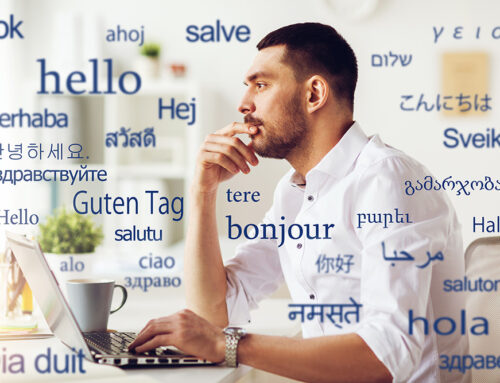
What goes into a high-quality translation?
The first step in creating a high-quality translation is ensuring that you have a high-quality source document (meaning the English version in most cases). Before sending it to a translation team, review the English text for readability and clarity. A murky paragraph in English will be equally difficult to understand in another language. Also check for cultural appropriateness. Many idioms and expressions are hard to translate. Aim for plain language when developing educational content, particularly if your goal is to translate.
Here are ways to simplify and strengthen your messages so that the translation is clear:
- Resist the urge to sound formal.
- Omit unnecessary detail.
- Be concise. Keep the average sentence below 25 words.
- Put only one main thought in most sentences.
- Use active voice.
- Avoid nominalizations – act, don’t take action; assume, don’t make assumptions; conclude, don’t draw conclusions.
- Use headings and topic sentences to summarize the main ideas of paragraphs.
- Use lists and bullet points.
3 topics to discuss with translators
One of your most important tasks is to clearly communicate the objectives of the translation project. Conversations with your translations provider should cover:
- Your document. Are you translating brochures, user manuals or marketing copy? Are these texts complete? In addition to all the text, make sure translators see related materials — images or videos, for example — so they are familiar with the entire project.
- Your target readers. What is their native language? What is their education level? What else do you know about them?
- Your purpose. How do you intend to use the translated text? Languages serve multiple functions: to educate, assist, request. Clarify your purpose and make sure translators know your goals. How do we review the translation? Poorly translated copy can do much more harm than good to your organization’s reputation. While reviewing another agency’s translations for one of our clients, we read a phrase that made us cringe. The client wanted to say, “We do not cut corners.” The other agency’s translation, however, was “No somos mezquinos,” meaning, “We are not misers.”
Not only did the translation not even remotely convey the company’s intended message, “mezquinos” is a crude word in Spanish that has absolutely no place in formal communications. Because no one on the company’s communication staff speaks Spanish, the improper phrasing appeared in newsletters distributed to all its employees!
If you don’t understand the target language, make translators prove their worth.
Find other people who grew up speaking and writing the target language — whether it’s Spanish or Mandarin Chinese — to thoroughly review the initial translation, even if you have to pay them. Then you can be assured your translations are correct. We recommend this practice to our clients.
Reviewers should focus on errors and barriers that might keep the consumer from understanding the intended message. Avoid random changes in style. Keep in mind that language is not an exact science. Just as we paraphrase our thoughts when we express opinions, words can be combined and expressed in different ways. In translation, information is transferred from one set of codes into a second set of codes, always taking meaning and style into account. A single message can have multiple accurate translations depending on the style and tone of the text.
The reviewers must be sure not to introduce regional variants and should possess a strong knowledge of syntax. Otherwise, they may introduce mistakes or false cognates into a translation, which is common with reviewers who are not word professionals.
10 checkpoints for every translation
A good translation process goes through checkpoints to ensure:
- Proper use of grammar, spelling and punctuation
- Appropriate capitalization (make sure the criterion applied is consistent throughout the text)
- Correct use of acronyms
- Review of units of measure, dates and numbers, as well as proper names
- Consistency with reference materials and glossaries
- Completeness of the translation (make sure nothing has been omitted)
- Exclusion of awkward or literal translations
- Fitting style and tone that reflect the client’s specific target audience
- Proper use of regional dialects and cross-cultural references, idioms and colloquialisms
- Proper formatting and layout
How can you tell if your nonprofit’s translations are effective?
The easiest test of translation effectiveness is a simple question: Does the translation sound like a translation? If it does, the translation is generally considered ineffective. Why? Because a text that leaves traces of its original is very distracting to a reader and detracts from the goal of your content.
To ensure effectiveness, you need to think about context, which for nonprofits generally involves:
Information: Giving instructions, explaining step-by-step procedures, or providing information about fees or benefits. When you translate to convey information, the information itself is more important than every detail about how the text is written. Ideally, the person who checks your information texts will be fully bilingual and have in-depth knowledge of your nonprofit’s inner workings to catch anything that is open to interpretation.
Persuasion: Raising awareness, getting people involved, or promoting a position or service by explaining benefits or engaging people’s emotions. When you translate to persuade an audience, style is more important than faithfulness to the original text, and your translation will likely need adaptation to be effective.
Even if a staff member took a year of Spanish in high school, this passing knowledge won’t be enough to check persuasive texts. Instead, ask a native speaker to read the translation and give you an opinion.
Trust your translation team
Once you have that relationship in place with a translation team, determining your context and getting the right person to check your texts are solid practices to make sure your translations are effectively driving your nonprofit’s mission.





